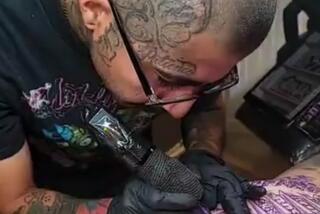Wide Expanses of Human Skin Exposed to Resurgent Polynesian Tattoos : New Zealand: A full Samoan tattoo is a mark of manhood and knowledge. Anyone who stops before the job is complete may be regarded as a coward. Women also wear the designs.
- Share via
AUCKLAND, New Zealand — In the back yard shed, the rhythmic tapping on red, raw flesh continued for hours.
“Don’t think about the pain; that will only make it worse,” Paul Suluape said, wiping a trickle of blood from the right arm of his grimacing customer.
Suluape is a tufuga tatau, or master tattooist, from Western Samoa--one of a growing number who practice the ancient, intricate craft in Auckland.
Samoan tattoos are as detailed as the process is long and painful.
A full set for a man requires many sessions over weeks, even months, to complete. It will cover his lower torso, from just above the waist down to his knees, with fine lines, swirls, dots and dashes. Bands on the upper arms also are common.
Women are tattooed from knees to ankles.
Auckland, the largest city in New Zealand, has about 170,000 Polynesians among its 1 million people, the largest concentration in the world. They have been lured south over more than 20 years by the hope of jobs, despite a climate too chilly for coconut palms.
Polynesians have been tattooing one another for at least 2,000 years. In the last century, Christian missionaries decried the practice as pagan, but could not stop it.
The current revival is particularly strong among young Samoans who were born in New Zealand and want to retain their cultural heritage.
Suluape, 43, began tattooing as a teen-ager, not long before moving to New Zealand. He sits cross-legged on a woven reed mat and the customer lies flat on his back or stomach.
Instead of the electric pens used in modern tattoo parlors, he works with a set of small combs with needle-sharp teeth, which he makes from turtle shell or pig tusks.
Each comb is bound to the end of a stick with twine. Suluape dips one comb into a bowl of black ink and holds another stick crosswise underneath to help steady his hand and control the tapping rhythm.
Although the tapping is light, it is firm enough for the teeth to pierce the skin, break tiny blood vessels and leave ink embedded.
Customers are sore for days afterward.
“The pain is like a burning sensation which builds and builds with every tap,” said Faa Viaelua, 25, a police officer of Samoan descent, who had a full tattoo earlier this year.
A full Samoan tattoo is a mark of manhood and knowledge. Anyone who stops before the job is complete may be regarded as a coward.
“It can bring great shame to your family,” Viaelua said.
Complete body tattoos are found in the Marquesas Islands of French Polynesia, and many forms of tattooing survive on most other South Pacific islands.
“It is one of Polynesia’s most vigorous arts,” said Roger Neich, an ethnologist at Auckland Museum. “The missionaries tried to stop it and failed. As far as we know, Polynesians have been tattooing themselves for as long as they have existed.”
Suluape’s motifs are strictly traditional, but are more decorative than symbolic.
“The design comes to me as I work,” he said.
Long ago, oily tree nuts were burned and the soot was used to make the ink. Some tattooists now use soot from kerosene lamps, but Suluape prefers commercial ink. He said it does not fade and the wounds heal more quickly, with less chance of infection.
His other concession to the 20th Century is hygiene. He cleans his combs with a sterilizing machine and chemicals similar to those used in hospital operating rooms.
A few white New Zealanders, known among Polynesians as Palangi, are among Suluape’s clients.
Pacific tattoos have fascinated foreigners for 200 years, since the first European seafarers dropped anchor off Samoa and peered through telescopes at the shore.
When they saw the tattoos, “the Palangi thought the Samoans were wearing pantaloons,” Suluape said.
Sailors corrupted the Polynesian word “tatau” and took their own version of the craft back to Europe.
More to Read
Sign up for Essential California
The most important California stories and recommendations in your inbox every morning.
You may occasionally receive promotional content from the Los Angeles Times.













